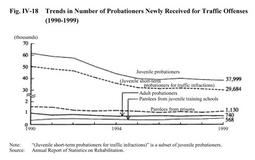| Previous Next Index Image Index Year Selection | |
|
|
3 Correction and rehabilitation of traffic offenders (1)Correction
Of new inmates for traffic offenses, those convicted for professional negligence had showed a downward trend in recent years, but turned up in1998and reached686persons in1999(533sentenced to imprisonment with labor and153to imprisonment without labor), up by89from the previous year. Persons convicted for Road Traffic Law violations have been increasing since 1996,reaching1,545persons in1999(1,544sentenced to imprisonment with labor and1to imprisonment without labor), up by123from the previous year. As shown in Table IV-7, almost half of those convicted for professional negligence in recent years have been sentenced to relatively long-term imprisonment of more than one year. About half of those newly convicted for traffic offences are detained in six designated facilities nationwide, including the Ichihara Prison. New traffic offense convicts detained in these prisons are adult inmates who are deemed suitable for open treatment and meet the following requirements: (i) They are not simultaneously serving a sentence of imprisonment with labor for any non-traffic offense; (ii) They have never been convicted for any non-traffic offense; (iii) The term of their sentence is about three months or more;and (iv) No physical or mental disorder has been identified. Therefore, living rooms, dining rooms, workshops, and other facilities are not locked in such prisons, and no body search is conducted for the inmates. Furthermore, no escorts are present in the prison premises, and interviews are allowed without the presence of guards as often as possible. Table IV-7 Number of New Inmates Convicted for Traffic Offenses by Type of Punishment and Term of Sentence(1990-1999) (2)Rehabilitation Fig. IV-18 shows the number of probationers newly received for traffic offenses(professional negligence or Road Traffic Law violations)over the last10years. Probationers for traffic offenses receive a treatment program in accordance with their characteristics. This may include treatment using guidebooks that systematically summarize the contents of guidance, lectures using audio-visual materials, and group treatment in such forms as meetings and workshops, all intended for the development of a law-abiding spirit, improvement of knowledge on careful driving, and formation of careful driving attitudes. Attempts are also made to improve the offenders'living and working environments, by seeking understanding and cooperation from family members and co-workers, for example. Advice on compensation to victims is also emphasized in the treatment of probationers for cases of death or bodily injury resulting from professional negligence(see Part 3 Section 2-6 for short-term probationary supervision for traffic infractions). Fig. IV-18 Trends in Number of Probationers Newly Received for Traffic Offenses(1990-1999) |

